
English Manual.

English Manual.
qStopMotion< is a program for creating stop motion animation movies from pictures you already have on your harddrive and from pictures you import live from a camera.
A stop motion animation is an animation which is built by taking many pictures of some objects while moving it a little between each picture. When these pictures are run you get an animation.










You can download the latest version of qStopMotion from the qStopMotion webpage https://www.qstopmotion.org.
Once you have installed qStopMotion you can start it by typing
qstopmotion
in a console or from menues:
When the program is started you will se the following:
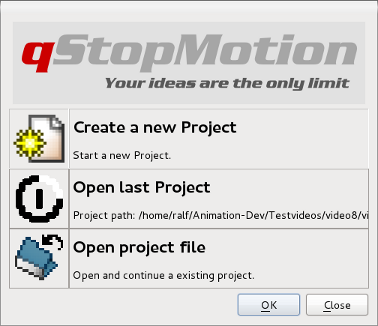
Now you have three possibilities of starting the using of qStopMotion:
If you select the new project possibility then the following dialog will open:
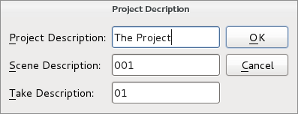
You can change the description for the animation project, the first scene of the project and the first take of the scene.
An animation project is organized in qStopMotion in the following way:
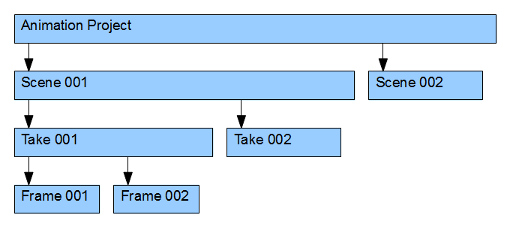
The animation project is the head of the structure. Each animation is segmented in scenes and each scene is segmented in takes. The take contain the single frames.
When the program is started you will se the following:
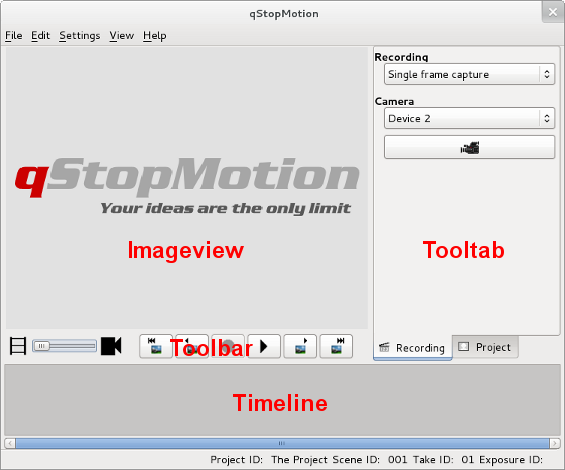
At the bottom you have the Timeline where you will see all the pictures in the animation.
The center area is the Imageview where you will get a closer look at your pictures, see the webcamera and preview your animation. At the bottom of the Imageview you have the Toolbar to navigate in the Timeline, take pictures and play the animation.
The right area are the Tooltabs. To switch between the different Tooltabs use the flags at the bottom of the Tooltabs.
qStopMotion starts with the selected Recording Tooltab.
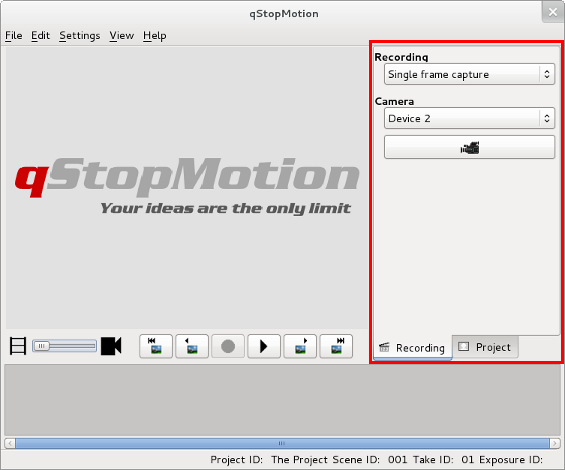
On the top of this tooltab you can select the recording method.
All connected video devices contain the next listbox.
At first you have to select one of these video devices.
Now you can also start the video device with the camera button ![]() .
.
The second Tooltab is the Project Tooltab.
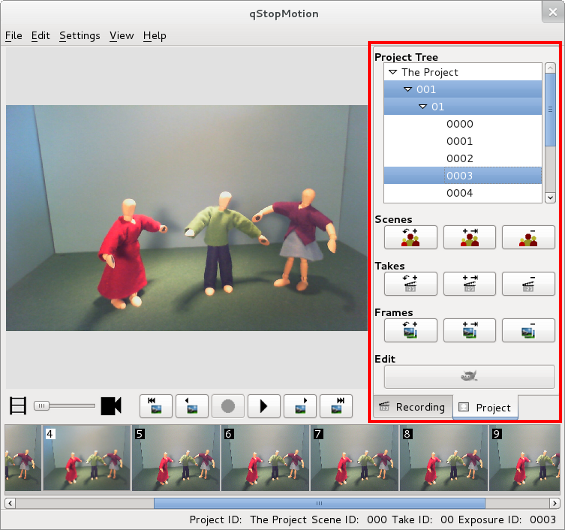
On the top of this tooltab you have the project tree containing all scenes, takes and frames of your animation.
Then you can see a line of buttons for:
The following line of buttons is for:
With the buttons in the last line you can:
Go back and select the recording tooltab.
Now you can also start the video device with the camera button ![]() .
.
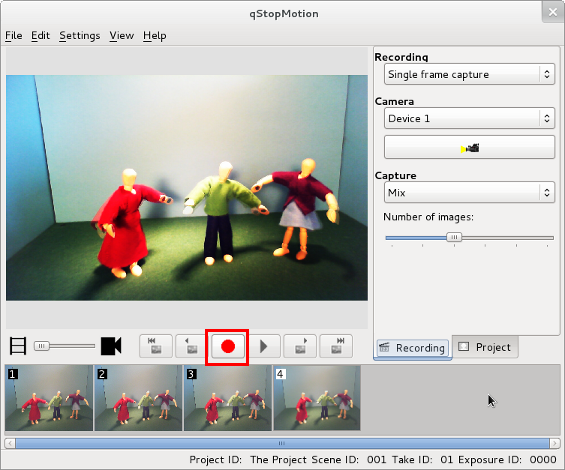
By pressing the capture button (![]() ) on the toolbar you will take a frame from the video stream displayed on the image view.
If you have taken some frames of your first animation, switch the camera off with the
) on the toolbar you will take a frame from the video stream displayed on the image view.
If you have taken some frames of your first animation, switch the camera off with the ![]() button.
button.
Now save the animation project to the hard disk using the save entry in the file menu. This will open the following dialog.
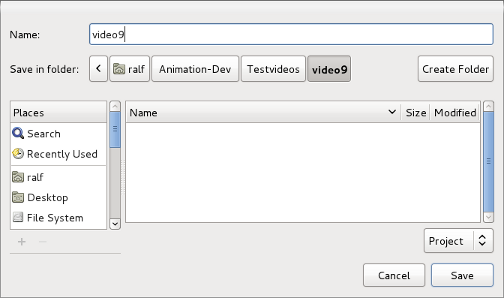
Navigate to an empty directory for your animation projects and create a new folder for the new project. Move to the new folder and type in the name for the project file. Then press the save button.
The next step is to try adding some pictures from the harddrive.
You can do this by clicking on the ![]() (Ctrl-F) button on the project tab on the right hand side.
(Ctrl-F) button on the project tab on the right hand side.
You will get the following dialog where you can select the pictures to add to the project:
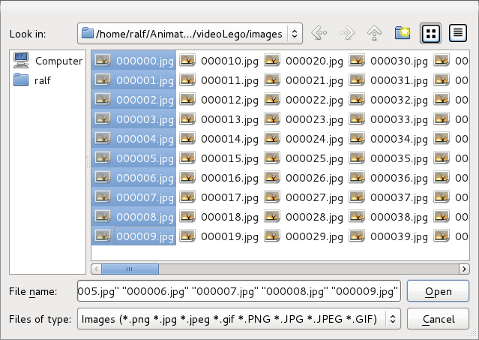
When you have selected some pictures you can click on the button and the pictures will be added to the project as frames.
Now that you have added some test pictures to your animations wouldn't you like to run them as an animation?
qStopMotion allows you to preview your animation before exporting it. This can be done through the play panel.
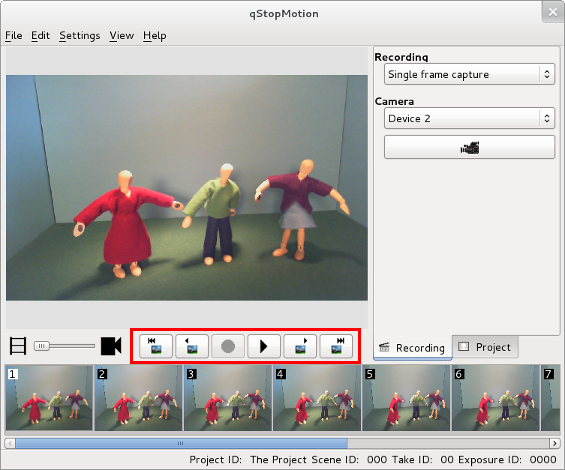
The play panel allows you to:
The camera has to be off to use this menu.
The real value of using qStopMotion lies in working directly against a camera.
If you have selected a video device, you can start the camera by pressing the ![]() (C) button.
(C) button.
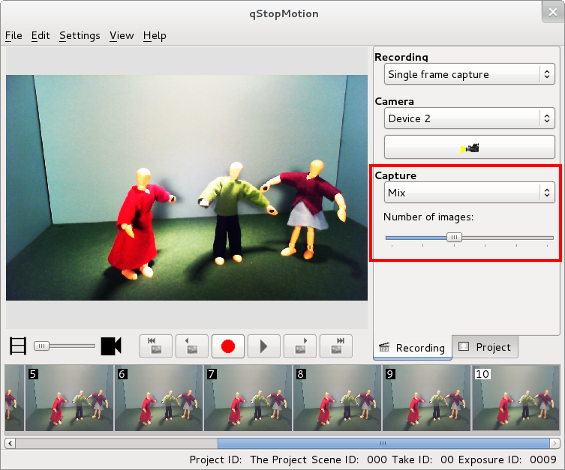
In order to do that you have to turn off all other programs using the camera.
When the camera is on you have three modes for viewing the video. These modes have different purposes and are there to assist you in creating your animations.
The image mixing is probably the view mode you will be using most of all. This mode allows you to view previous pictures (up to five) on top of the camera. This way you can position the figure in relation to the previous frames so that you can create smooth motions.
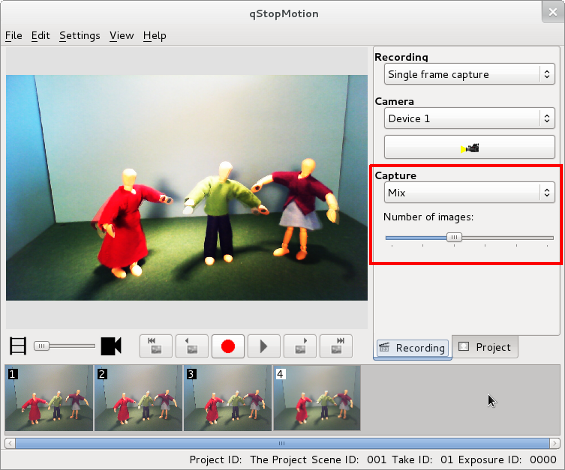
You can change the number of pictures to view on top of the camera with the "Number of mixes'' slider on the camera panel.
The image differentiation mode is primarily meant as a tool for moving the figure back to a previous position.
It displays the difference between the selected frame and the camera. This way, if an object in front the camera has been involuntairly moved (fallen, etc) you can use the differentiation mode, together with the image mixing, to move the object back to its previous position.
This can be done by moving the figure until the picture is black, which means the selected frame and the camera are "equal''.
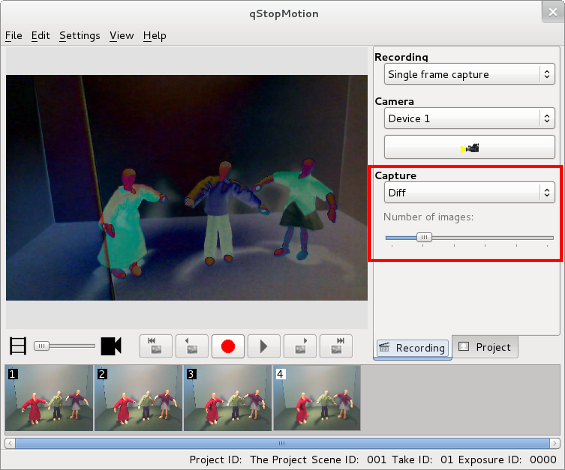
The playback mode will continously run the the already recorded frames as an animation with the input from the camera as the final frame.
This way you can see the camera input, which will become the next frame, together with the previous frames as an animation.
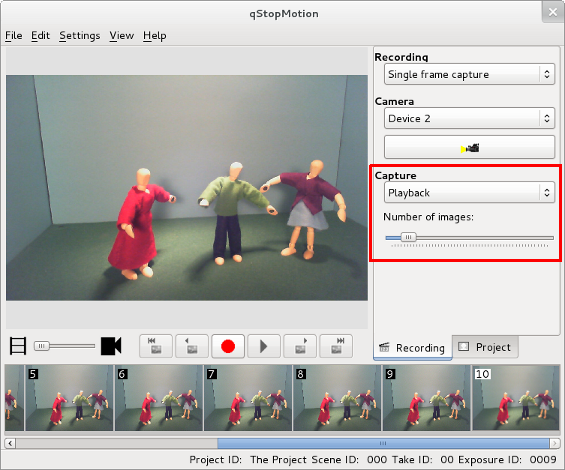
You can specify how many frame backwards should be played (up to 50) with the "Number of images'' slider on the camera panel, and you can set how fast they should played with the FPS chooser on the preview panel.
For some camera types it is possible to control the settings of the camera using the camera controller.
If your camera supports the camera control functionality, you can open the camera controller window by selecting the 'Camera Controller' entry in the 'Windows' menu.

In order to do that you have to turn off all other programs using the camera. Also remove the camera memory from the file system.
On the right side of the qStopMotion window the camera control window will open.

When the camera is on you have two blocks of control possibilities, one block for the video quality of the camera and one for the camera control. These blocks have different number of controlls depending on the control capabilities of your camera. If the camera have the possibility of automatic control capabilities this can switched on or off.
Yyy.
Yyy:
Yyy.
Yyy:
One especially useful example of using qStopMotion with other programs is to use gimp (or another painting program) to add effects to the frames.
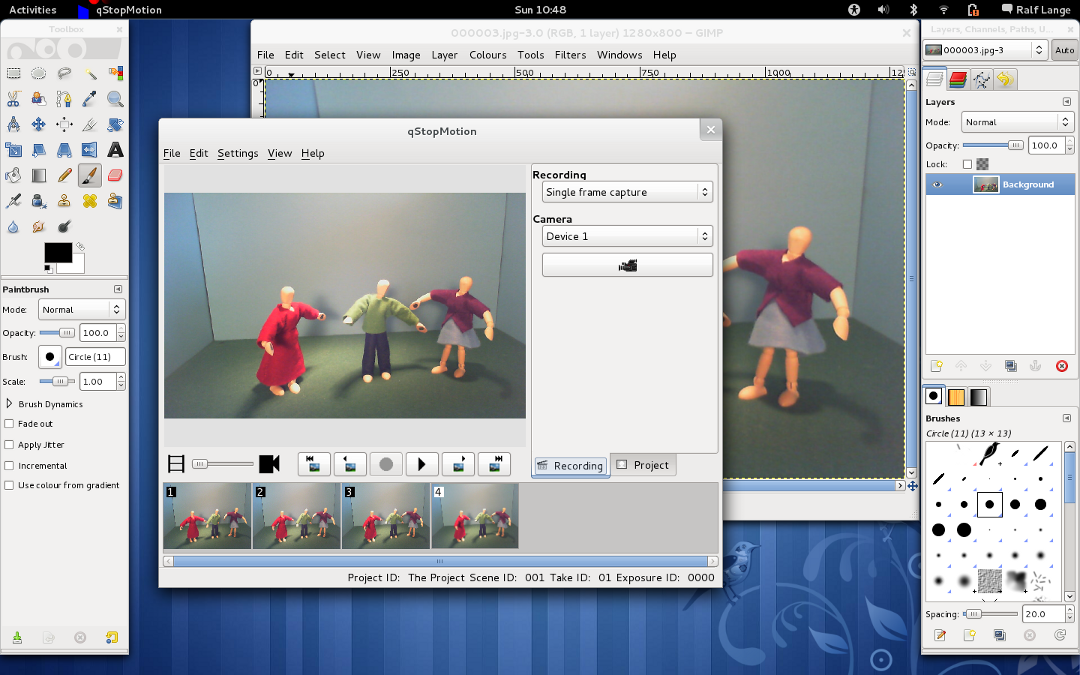
The best way to do this is to select the frame in the project tree of qStopMotion and pressing the gimp button to start gimp. Change around with it in gimp, then save the picture in gimp (-> (Ctrl-S)) (not save as).
qStopMotion should detect the changes automatically.
By now you should have a nice animation of your own. It's time to make a video file of it.
The first thing you need to do is to install a video encoder. If you have mplayer installed, you should already have one you can use.
Go to the Preferences menu (-> (Ctrl-P)) and press the tab. You should now get a list of video export settings:

Change the video export setting to the format, size and frame rate you like. When you have set up a video export setting you can close the Configure menu by pressing the OK button.
To export your animation to a video file just press ->-> (Ctrl-Alt-V) and you should have a video file of your excellent animation. Tell your friends!
If you want access to the image files in your animation project you can open project directory in your file browser.
The directory is structured in the following way:
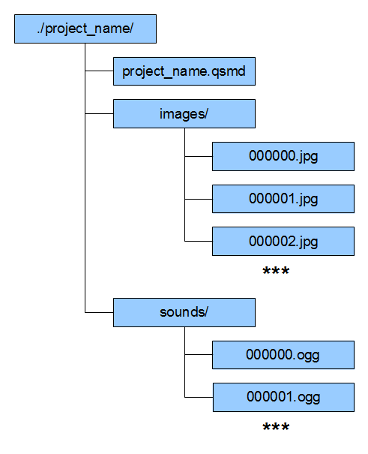
Xxx.
Normal text.
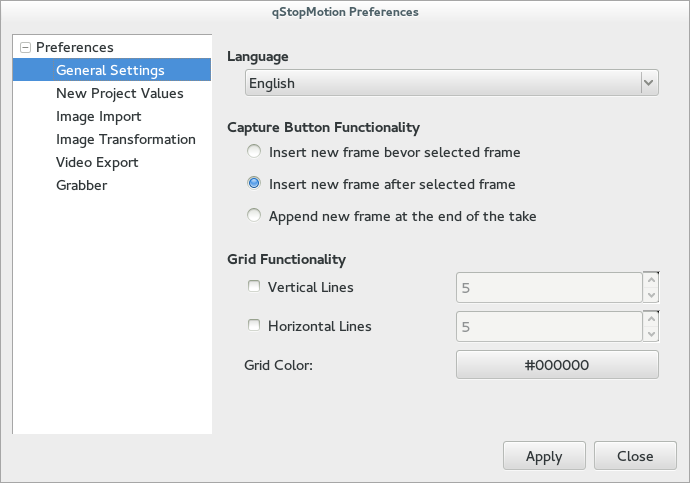
Text.
Normal text.
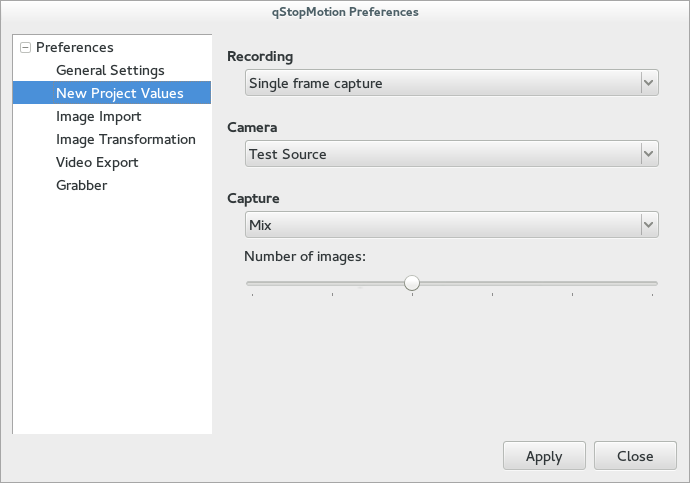
Text.
If the image importing doesn't work or if you want other settings you can change the way images are imported in qStopMotion.
This is done through the configure menu (-> (Ctrl-P)) and you can either choose from one of the predefined settings or create your own.
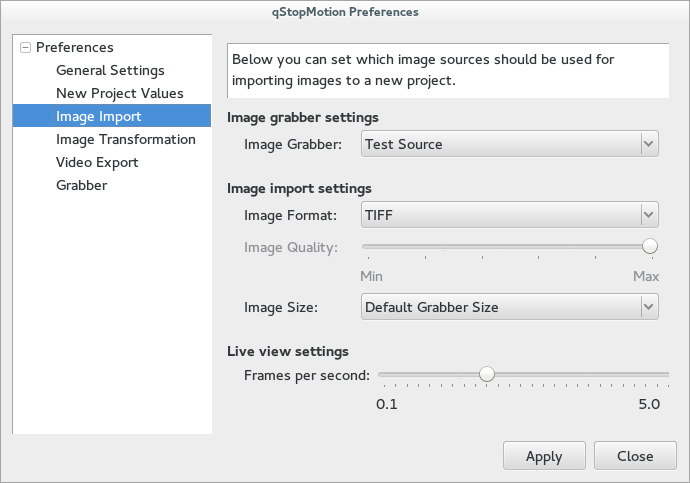
Image importing in qStopMotion works by continously asking an external program to grab a picture from the camera and place it in the qstopmotion directory. qStopMotion then displays this picture, and when this is done continously you get live video.
If you want to add a new import program you can do this by pressing the button. A new row appears in the table and you can fill in a name for your setting and a short description.
You then have to specify the command line options to import pictures. These can be set by selecting your setting and pressing the button.
There are three things which can be specified here. The prepoll, start deamon and stop deamon fields. If the program for importing the images grabs one image and then exits you can leave the start and stop deamon fields blank. The contents of the prepoll field is a command which is run before importing a picture. If the import program is running in the foreground this will typically be the command line for grabbing the picture. Note that you have to write (DEFAULTPATH) in the command line on the place you otherwise would have speciefied the path to the file where the image should be stord. qStopMotion will replace this tag with the correct path and file name.
If the program you use for importing the pictures is running as a background/deamon process you have to specify command lines for starting and stoping the deamon. Again you should use the $importpath tag instead of the path to the file (se above). Prepoll could still be used but is not required. One potential use for the prepoll command when the grab program is running as a deamon process is to specify a command line which performes a operation such as scaling or rotating the picture. This command will be called on the pictures every time before importing them meaning the live video will be displayed with the effect.
Normal text.
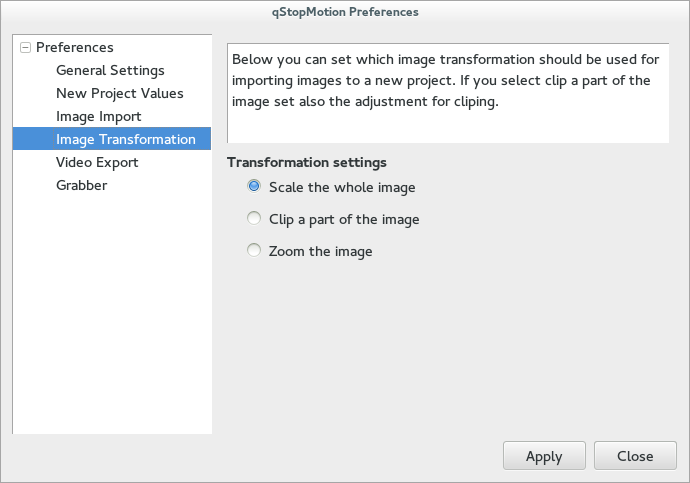
Text.
Normal text.

Text.
Normal text.
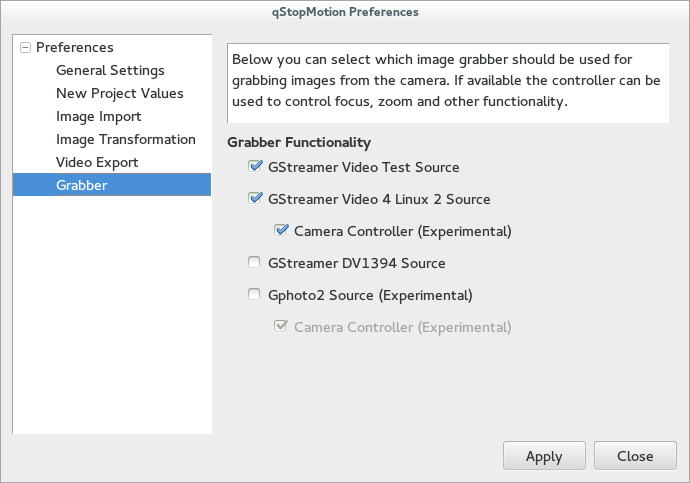
Text.
Normal text.
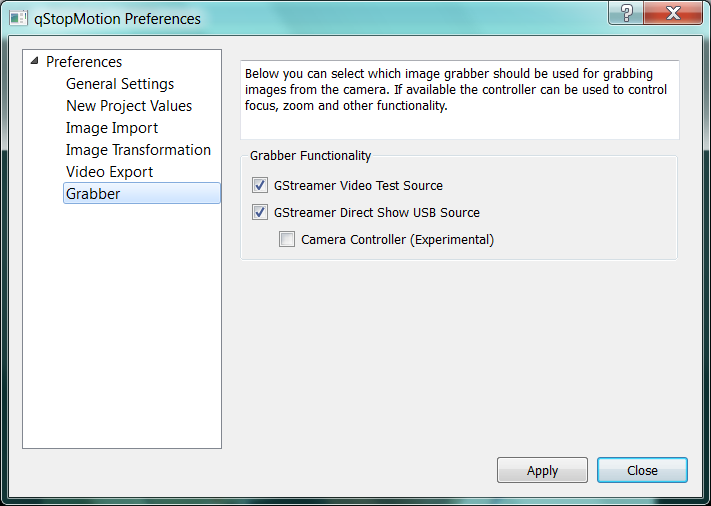
Text.
Lead text.
Normal text.
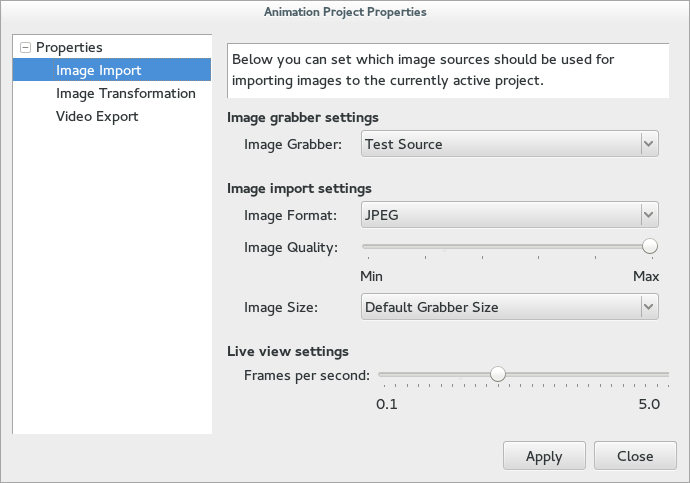
Text.
Normal text.
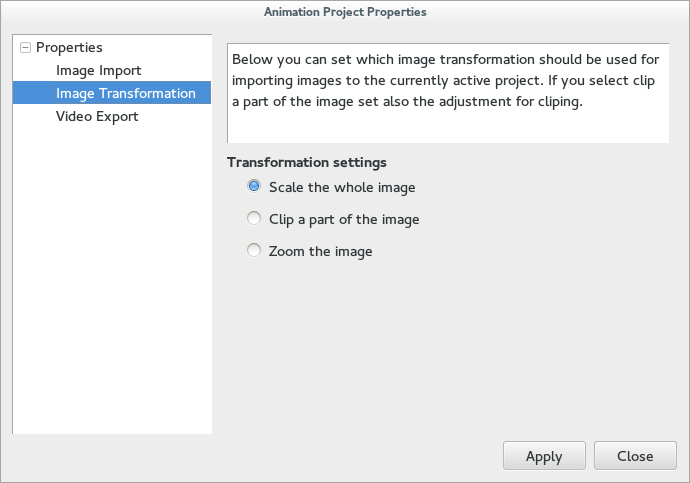
Text.
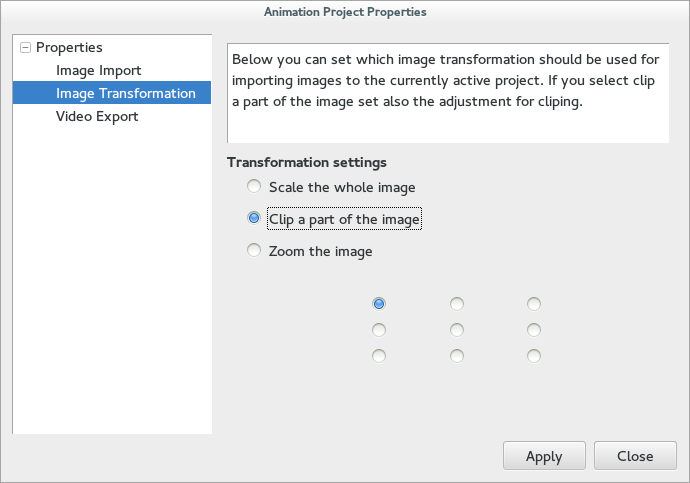
Text.
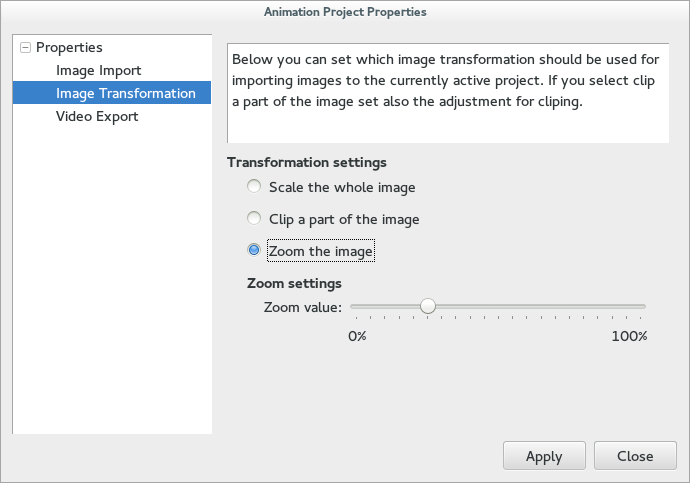
Text.
Normal text.
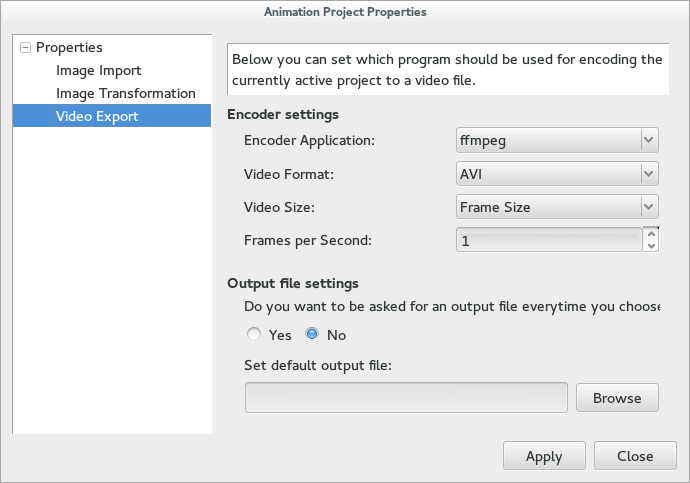
Text.
Lead text.
Normal text.
| Key | Description |
|---|---|
| Ctrl-N | Creates a New project. |
| Ctrl-O | Opens an excisting project. |
| Ctrl-S | Saves the project. |
| Ctrl-Shift-S | Saves the project as. |
| Ctrl-Alt-V | Opens a dialog to export the project as video. |
| Ctrl-Alt-C | Opens a dialog to export the project as a Cinerella project. |
| Ctrl-Q | Quits the application. |
| Ctrl-Z | Undoes the last action. |
| Ctrl-Shift-Z | Redoes the last undo. |
| Ctrl-X | Cuts the selected frames out of the animation and places them on the global clipboard. |
| Ctrl-C | Copies the selected frames to the global clipboard. |
| Ctrl-V | Pastes pictures from the global clipboard and adds them to the animation after the selected frame. |
| Ctrl-G | Brings up a menu where you can select a frame to jump to. |
| Ctrl-P | Opens the import and export preferences menu. |
| Shift-F1 | Gives you a what's this arrow for querying information about a user interface item. |
| Ctrl-F | Adds one or several frames/pictures to the animation. |
| Ctrl-E | Creates a new scene |
Normal text.
| Key | Description |
|---|---|
| Space | Play the animation. |
| *, P, Asterisk | Go to the last frame of the take. |
| 9, Page Up | Go to the next frame of the take. |
| 6, O, Right | Go to the previous frame of the take. |
| 3, L, Page Down | Go to the first frame of the take. |
| /, Slash | Go to the last take of the scene. |
| 8, Up | Go to the next take of the scene. |
| 5, I, Clear | Go to the previous take of the scene. |
| 2, K, Down | Go to the first take of the scene. |
| 7, Home | Go to the last scene of the project. |
| 4, U, Left | Go to the next scene of the project. |
| 1, J, End | Go to the previous scene of the project. |
| 0, M, Insert | Go to the first scene of the project. |
| Space | Toggle whether the animation should loop when playing. |
Lead text.
Normal text.
The program tells me it can't import images.